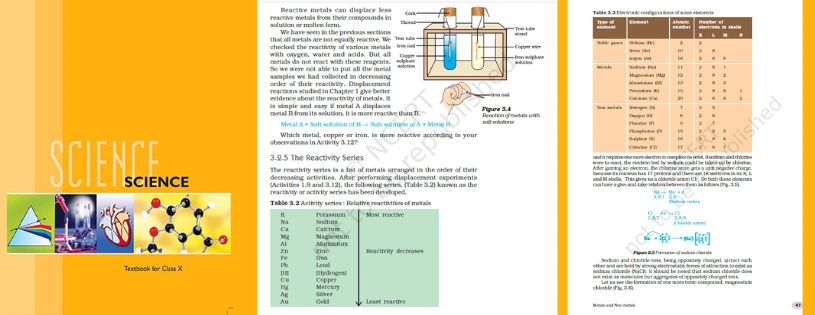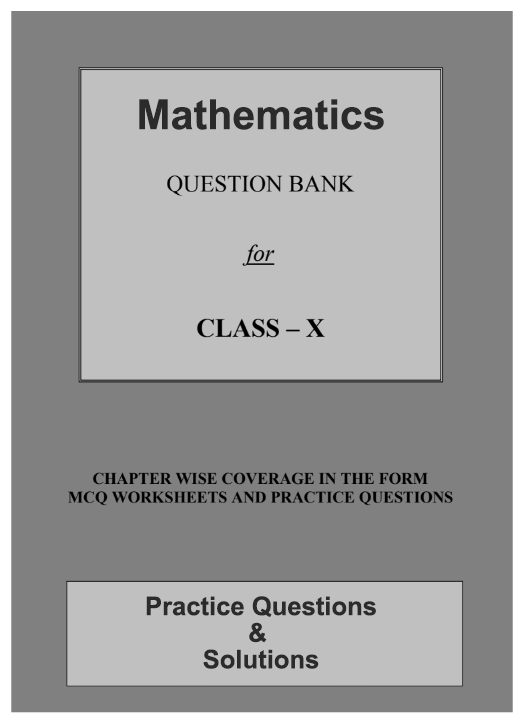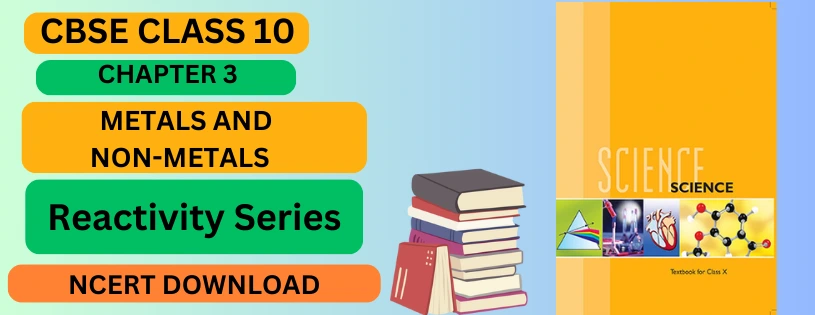In this educational odyssey, we navigate the intricacies of the Reactivity Series, a cornerstone concept that not only enriches our theoretical knowledge but also unveils practical applications in our daily lives. As we unravel the mysteries of chemical reactivity, the CBSE NCERT guide becomes our compass, and the download of knowledge from its pages propels us forward into a deeper comprehension of the Reactivity Series and its implications in the vast landscape of chemistry.
Unlocking Chemical Insights: CBSE NCERT Download on the Reactivity Series
What is the Reactivity Series?
The Reactivity Series is a list of metals arranged in order of their decreasing reactivity. This series serves as a handy tool for predicting the outcome of displacement reactions and understanding the behavior of metals in different chemical environments.
The standard Reactivity Series commonly introduced in classrooms includes metals such as potassium, sodium, calcium, magnesium, aluminum, zinc, iron, lead, copper, silver, and gold.
Ordering Metals by Reactivity
Highly Reactive Metals
At the top of the Reactivity Series, we find highly reactive metals such as potassium and sodium. These metals are so reactive that they can react vigorously with water, producing hydrogen gas and hydroxide ions.
2K+2H2O→2KOH+H2↑2K+2H2O→2KOH+H2↑
Moderately Reactive Metals
Moving down the series, we encounter metals like aluminum, zinc, and iron. These metals react with acids but not as vigorously as the highly reactive ones. For instance, zinc reacts with hydrochloric acid to produce zinc chloride and hydrogen gas.
Zn+2HCl→ZnCl2+H2↑Zn+2HCl→ZnCl2+H2↑
Low Reactivity Metals
Metals at the bottom of the Reactivity Series, such as copper and silver, are less reactive. They don't readily react with water or acids. In fact, silver hardly reacts with most common acids.

Download Science notes
Important uses of Reactivity Series
Apart from providing insight into the properties and reactivities of the metals, the reactivity series has several other important applications. For example, the outcome of the reactions between metals and water, metals and acids, and single displacement reactions between metals can be predicted with the help of the activity series.
Reaction Between Metals and Water
Calcium and the metals that are more reactive than calcium in the reactivity series can react with cold water to form the corresponding hydroxide while liberating hydrogen gas. For example, the reaction between potassium and water yields potassium hydroxide and H2 gas, as described by the chemical equation provided below.
2K + 2H2O → 2KOH + H2
Therefore, the reactivity series of metals can be used to predict the reactions between metals and water.
Reaction Between Metals and Acids
Lead and the metals ranking above lead on the activity series form salts when reacted with hydrochloric acid or sulphuric acid. These reactions also involve the liberation of hydrogen gas. The reaction between zinc and sulphuric acid is an example of such a reaction. Here, zinc sulfate and H2 gas are formed as products. The chemical equation is:
Zn + H2SO4 → ZnSO4 + H2
Thus, the reactions between metals and some acids can be predicted with the help of the reactivity series.
Single Displacement Reactions Between Metals
The ions of low-ranking metals are readily reduced by high-ranking metals on the reactivity series. Therefore, low-ranking metals are easily displaced by high-ranking metals in the single displacement reactions between them.
A great example of such a reaction is the displacement of copper from copper sulfate by zinc. The chemical equation for this reaction is given by:
Zn (s) + CuSO4 (aq) → ZnSO4 (aq) + Cu (s)
This concept has several practical applications in the extraction of metals. For example, titanium is extracted from titanium tetrachloride via a single displacement reaction with magnesium. Thus, the reactivity series of metals can also be used to predict the outcome of single displacement reactions.
Salient Features
- The metals at the top of the reactivity series are powerful reducing agents since they are easily oxidized. These metals tarnish/corrode very easily.
- The reducing ability of the metals grows weaker while traversing down the series.
- The electro-positivity of the elements also reduces while moving down the reactivity series of metals.
- All metals that are found above hydrogen in the activity series liberate H2 gas upon reacting with dilute HCl or dilute H2SO4.
- Metals that are placed higher on the reactivity series can displace metals that are placed lower from their salt solutions.
- Higher-ranking metals require greater amounts of energy for their isolation from ores and other compounds.
Another important feature of the activity series is that while traveling down the series, the electron-donating ability of the metals reduces.
CBSE Class 10th Downloadable Resources:
Being in CBSE class 10th and considering the board examinations you must be needing resources to excel in your examinations. At TestprepKart we take great pride in providing CBSE class 10th all study resources in downloadable form for you to keep you going.
Below is the list of all CBSE class 10th Downloads available on TestprepKart for both Indian and NRI students preparing for CBSE class 10th in UAE, Oman, Qatar, Kuwait & Bahrain.
SAMPLE PRACTICE QUESTION
Q1: What is the Reactivity Series?
Ans: The Reactivity Series is a list of metals arranged in order of their reactivity, with the most reactive metals at the top and the least reactive at the bottom.
Q2: How is the Reactivity Series useful in chemistry?
Ans: The Reactivity Series is useful in predicting the outcomes of chemical reactions. It helps determine which metals can displace others from their compounds and the likelihood of a metal reacting with acids.
Q3: What happens when a metal is placed higher in the Reactivity Series than another metal?
Ans: A metal higher in the Reactivity Series can displace a less reactive metal from its compounds. This displacement reaction involves the more reactive metal taking the place of the less reactive one in a compound.
Q4: Why do metals higher in the Reactivity Series react more vigorously with acids?
Ans: Metals higher in the Reactivity Series have a greater tendency to lose electrons. When they react with acids, they can donate electrons more readily, resulting in a more vigorous reaction, often producing hydrogen gas.
Q5: How does the Reactivity Series help in the extraction of metals from their ores?
Ans: The Reactivity Series aids in selecting suitable methods for metal extraction. Metals higher in the series are often extracted through reduction processes, while less reactive metals may be found native or extracted through simpler methods.

Download Question Bank


Post a Comment